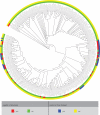Absence of mammals and the evolution of New Zealand grasses
- PMID: 20826486
- PMCID: PMC3030840
- DOI: 10.1098/rspb.2010.1145
Absence of mammals and the evolution of New Zealand grasses
Abstract
Anthropogenic alteration of biotic distributions and disturbance regimes has dramatically changed the evolutionary context for the differentiation of species traits. Some of the most striking examples in recent centuries have been on islands where flightless birds, which evolved in the absence of mammalian carnivores, have been decimated following the widespread introduction of exotic predators. Until now, no equivalent case has been reported for plants. Here, we make use of robust analytical tools and an exceptionally well-sampled molecular phylogeny to show that a majority of New Zealand danthonioid grasses (Poaceae) may have adapted to the relaxed vertebrate herbivore pressure during the late Cenozoic through the development of a distinctive and unusual habit: abscission of old leaves. This feature occurs in only about 3 per cent of the world's roughly 11,000 grass species and has been empirically shown to increase plant productivity but to reduce protection against mammal grazing. This result suggests that release from a selective pressure can lead to species radiations. This seemingly anachronistic adaptation may represent an overlooked factor contributing to the severe decline in the geographical extent and species diversity of New Zealand's indigenous grasslands following the introduction of herbivorous terrestrial mammals in the 19th century.
Figures




References
-
- Temple S. A. 1979. The dodo and the tambalacoque tree. Science 203, 1364.10.1126/science.424762 (doi:10.1126/science.424762) - DOI - DOI - PubMed
-
- Guimarães P. R., Jr, Galetti M., Jordano P. 2008. Seed dispersal anachronisms: rethinking the fruits extinct megafauna ate. PLoS ONE 3, (doi:10.1371/journal.pone.0001745) - DOI - PMC - PubMed
-
- Janzen D. H., Martin P. S. 1982. Neotropical anachronisms: the fruits the gomphotheres ate. Science 215, 19–2710.1126/science.215.4528.19 (doi:10.1126/science.215.4528.19) - DOI - DOI - PubMed
-
- Johnson C. N. 2009. Ecological consequences of Late Quaternary extinctions of megafauna. Proc. R. Soc. B 276, 2509–251910.1098/rspb.2008.1921 (doi:10.1098/rspb.2008.1921) - DOI - DOI - PMC - PubMed
-
- Bond W. J., Silander J. A. 2007. Springs and wire plants: anachronistic defences against Madagascar's extinct elephant birds. Proc. R. Soc. B 274, 1985–199210.1098/rspb.2007.0414 (doi:10.1098/rspb.2007.0414) - DOI - DOI - PMC - PubMed
Publication types
MeSH terms
LinkOut - more resources
Full Text Sources

